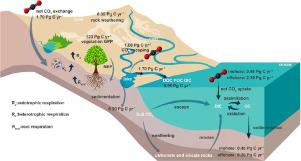Carbon transportation, transformation, and sedimentation processes at the land-river-estuary continuum
IF 6.2
3区 综合性期刊
Q1 Multidisciplinary
引用次数: 0
Abstract
In terrestrial ecosystems, carbon (C) transportation and C pool transformation processes both occur at the land-river-estuary continuum. Moreover, C budget and C balance processes are generally critical in achieving the C neutrality of terrestrial ecosystems. This study analyzes key C transportation processes at multiple interfaces that collectively constitute the land-river-estuary continuum, discusses C transportation and sedimentation processes at the land-river interface, and reveals aquatic plant C sequestration coupling processes and associated productivity. Transformation mechanisms of inorganic-organic C pools are also investigated here as well as a systematic evaluation of C transport flux within the different interfaces that constitute the land-river-estuary continuum. Results show that the net C sink of terrestrial ecosystems was 1.70 Pg C yr−1, wherein the gross primary productivity (GPP) of global terrestrial vegetation reached 123 Pg C yr−1, while rock weathering also consumed 0.30 Pg C yr−1 of atmospheric carbon dioxide (CO2). Subsequently, the C transported by the land-river-estuary continuum reached 1.70 Pg C yr−1. During this process, 0.20 Pg C is deposited and buried in inland water and 1.00 Pg C escapes from inland water systems each year. Therefore, only 0.85 Pg C is transported to the estuary. Finally, this study clarifies control mechanisms of C transportation and transformation processes at the land-river-estuary continuum. The aim of this study is to provide an important scientific basis for the quantitative analysis of C sources and sinks at the land-river-estuary continuum and C neutrality of the biosphere.

陆地-河流-河口连续体的碳运输、转化和沉积过程
在陆地生态系统中,碳(C)运输和碳库转化过程都发生在陆地-河流-河口连续体中。此外,碳预算和碳平衡过程通常是实现陆地生态系统碳中性的关键。本研究分析了共同构成陆地-河流-河口连续体的多个界面上的关键碳输运过程,讨论了陆地-河流界面上的碳输运和沉积过程,揭示了水生植物碳固存耦合过程及其相关生产力。本文还研究了无机-有机碳库的转化机制,并对构成陆地-河流-河口连续体的不同界面内的碳输运通量进行了系统评价。结果表明,陆地生态系统的净碳汇为1.70 Pg C yr - 1,其中全球陆地植被的总初级生产力(GPP)达到123 Pg C yr - 1,而岩石风化也消耗了0.30 Pg C yr - 1的大气二氧化碳(CO2)。随后,陆地-河流-河口连续体输送的C达到1.70 Pg C yr−1。在这一过程中,每年有0.20 Pg C沉积和埋藏在内陆水中,1.00 Pg C从内陆水系中逸出。因此,只有0.85 Pg C被输送到河口。最后,阐明了陆地-河流-河口连续体中碳运移转化过程的控制机制。本研究旨在为陆地-河流-河口连续体C源汇和生物圈C中性定量分析提供重要的科学依据。
本文章由计算机程序翻译,如有差异,请以英文原文为准。
求助全文
约1分钟内获得全文
求助全文
来源期刊

Fundamental Research
Multidisciplinary-Multidisciplinary
CiteScore
4.00
自引率
1.60%
发文量
294
审稿时长
79 days
期刊介绍:
 求助内容:
求助内容: 应助结果提醒方式:
应助结果提醒方式:


